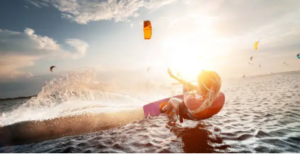Foil surfing, also known as hydrofoiling, is a new water sport taking surfers by storm. It’s a different experience than traditional surfing, as riders soar a few feet above the water’s surface.
 Foil boards have sharp components that can cause severe injuries to swimmers or surfers who collide with them. These risks are more significant if foil surfers use their equipment in areas where traditional surfers and swimmers share the same waters. For more information about the Assault-Boardriding foiling, click here.
Foil boards have sharp components that can cause severe injuries to swimmers or surfers who collide with them. These risks are more significant if foil surfers use their equipment in areas where traditional surfers and swimmers share the same waters. For more information about the Assault-Boardriding foiling, click here.
Surf
Foiling is a great new addition to surfing, and it has taken the world by storm. You’ve probably seen top surfers like Kai Lenny gliding gracefully above the water or Zane Schweitzer carving unique foil lines in the surf on your social media feeds.
In a nutshell, you ride a specialised surfboard with a hydrofoil mounted underneath towards the back. The foil generates a lift that raises the board from the water, creating a feeling unlike anything else in water sports.
Foiling is challenging to learn, but if you’ve got some previous watersports experience like prone surfing, sup, kiteboarding, windsurfing or even just kayaking, you’ll have an edge. You must also be physically fit and understand how to read ocean swells. For the best results, you want small crumbly waves where you can catch whitewater and slowly increase your back foot pressure to get on foil.
Down winding
When we see top surfers like Kai Lenny or Zane Schweitzer gracefully gliding above the water on a foil, they’re likely downwind. It is one of the most exciting new forms of SUP foiling that allows you to use a foil in windy ocean conditions where it would be difficult or impossible to paddle without the added wind wing.
Foil downwinding requires a lot of skill and finesse. You need to be able to read the waves and winds and shift your feet to keep the foil under the surface and provide power. It’s fantastic to fly above the water at speeds you can’t even reach on a conventional board.
The shape of the foil’s front wing determines how much it turns, so you can change how it responds to different conditions by altering the wing’s curve. Also, the mast length determines how high you can ride the foil above the water surface. A shorter mast allows you to hang the foil lower and is easier to learn.
Safety
Foiling is a new watersport requiring some physical fitness and knowledge. Some experience with other watersports is helpful but not mandatory. Foiling is much easier if you have previous surf or waterskiing expertise and are comfortable jumping off a ramp or falling in the surf. The foil wing floats and will cushion the fall. Be sure to rinse your mast and use tef-gel on the foil screws.
A 6′ Semi-Coil leash avoids interference with the foil when paddling and has a straight segment for connecting at the calf or knee, with a Velcro connection that won’t pull on your feet. This leash is designed for foiling and comes in Aluminum or Carbon. Foil fins are designed to maximise lift over a wide range of angles of attack, maintain laminar flow around the fin and minimise drag. These features are referred to as the “lift-to-drag ratio.” The shape of the fin is called planform.
Equipment
Foiling uses an aerodynamic hydrofoil to generate lift, minimising friction or drag with the water. The foil attaches underneath the board and uses areas of high and low pressure to generate thrust, similar to an aeroplane wing. It lifts the board and rider out of the water, creating a flying feeling unlike anything else in water sports.
You will also need a mast that fits the foil. There are many options, from short masts that are easier and more forgiving to learn to longer masts that can provide better speed and control in rougher water conditions. You will need a helmet and wetsuit as sharp foils can cause serious injury when learning. For more information about the Assault-Boardriding foiling, click here.